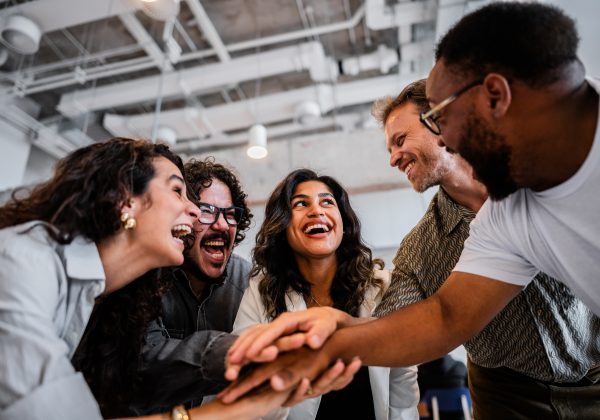Homefront Advantage
Courtney Geduldig has been described as a tenacious and fearless game-changing leader.
Colleagues say that you want Ms. Geduldig on your team in a crisis situation because she will lead calmly and decisively while thinking several steps ahead of everyone else.
And when the crisis is a pandemic and the circumstances demand a different style of thinking and leadership, Ms. Geduldig will drive innovative approaches to better serve customers and lead with flexibility and empathy for her teams.
Ms. Geduldig, chief public and government affairs officer for S&P Global, is responsible for leading global government relations, internal and external communications, operations, research and insights content, and corporate event operations.
Like many executive leaders this year, this working mother also learned to navigate virtual meetings while managing background distractions, such as a barking dog, and parental responsibilities, like giving her kids a ride home from school. But one thing she has taken advantage of while working remotely during the COVID-19 pandemic is the opportunity to get to know her employees better on a personal level.
“If we want our people to feel like they can bring their true selves to work and flourish, they need to see that my leadership team and I are invested in them not just as employees, but also as people.” —Courtney Geduldig
“It ends up being pretty easy when you’re home. When your teenage kids walk into the room behind you, or this morning, my dog stuck his nose right in front the camera when I was on the screen—inevitably, it’ll happen when you’re on with the CEO,” she says. “I think the more that those things happen, the more people get to know each other.”
This is important, Ms. Geduldig says, because a team that is effective and works well together is one in which there are strong bonds of trust and accountability.
“You can’t have those bonds unless you know the people you’re working with deeper than surface level. We are all human beings with families, homes, pets, hobbies, personal challenges and more outside of the office,” she says. “If we want our people to feel like they can bring their true selves to work and flourish—in both work and life—they need to see that my leadership team and I are invested in them not just as employees but also as people.”—Courtney… Share on X
“There Is No Playbook for This Kind of Crisis”
Prior to joining S&P Global in 2013, Ms. Geduldig was the managing director and head of federal government relations at the Financial Services Forum, a nonpartisan financial services and economic policy organization.
Her CV also includes roles as vice president of global regulatory affairs at Standard & Poor’s and deputy assistant secretary for banking and finance at the U.S. Department of the Treasury. She is also the co-author of Where the Jobs Are: Entrepreneurship and the Soul of the American Economy, a book that explores the issues, frustrations and obstacles confronting entrepreneurs.
S&P Global, which had an annual revenue of $6.7 billion last year, provides ratings, benchmarks, analytics and data to capital and commodity markets worldwide. Over the course of more than 150 years, it has built a legacy of providing essential and trusted intelligence to the world’s financial markets.
With an eye toward the future, the company has always been driven to meet the ongoing and projected needs of its customers. For example, in 1957, the company introduced the world’s first computer-generated stock index, the S&P 500. Since then, key acquisitions, such as SNL Financial, Kensho Technologies, Panjiva and RobecoSAM’s ESG Ratings Business, have allowed S&P Global to continue to offer the cutting-edge capabilities needed to provide the analytics, data and insight its customers demand.
S&P Global employs nearly 23,000 people in 35 countries. When the coronavirus pandemic shut down much of the U.S. in March, the company—like many others—learned to shift how it operates and serves customers.
Market participants need up-to-the-minute information so they can make informed financial decisions, which is especially challenging during times of volatility. With this in mind, the team’s research is captured on a dedicated COVID-19 page on the company website. In addition, S&P Global has also published research in areas such as the impacts on utilities, particularly oil; climate risk and energy; China and emerging markets; and the credit and debt markets.
Ms. Geduldig’s teams have learned to be innovative and leverage technology in new ways to serve customers. Likewise, S&P Global leaders like her have been tested this year in ways that could not have been predicted at the outset of 2020.
“I think this has been a challenge for all of us at all times,” Ms. Geduldig says. “There is no playbook for this kind of crisis, just as there’s no playbook for the financial crisis. In both cases, people have been deeply impacted.”
She adds that the killing of George Floyd while in police custody has brought legacy issues of racism and social injustice to the forefront of national conversations. “As leaders, we have needed to become allies for [Blacks] and lead by example, engaging in open dialogue with our teams. Just because we’re uncomfortable doesn’t mean we have to stay silent,” she says. “We will be judged at the close of our professional careers by how we treated our colleagues, our employees and our customers. We will not get it right all the time, but hopefully we will at least be seen as having tried to do the right thing every time.”
On Digital Transformation
“For a long time, we’ve been talking about digital transformation in the business community. We’d put a five- to seven-year timeline on [it]. And then, all of a sudden, the optionality was gone when the pandemic happened. I think it was easier than we thought, but it’s not perfect, and it’s sort of an evolution in progress. We’re trying to figure out how to use it better. Our technology leaders have done a remarkable job; we are very fortunate to be able to work remotely.
“Courtney is not afraid to make a decision and move on. While she clearly hates to fail, she is not scared of it because she knows that by the time it comes to making that decision, she has exhausted every resource at her disposal to get the call right.” —Dave Guarino, Chief Communications Officer, S&P Global
“What’s been fascinating to me is, I think we assumed that the leadership, managers, the more seasoned part of the workforce would have a harder time with it. And that the younger employees would have a much easier time—that they were just so much more used to technology. I think we’ve seen some of that happening in the context of the functionality and trying out some of the new technology, but we’ve also seen some of the opposite of that. Even more seasoned team members are finding ways to make tech work.
“Our younger employees are the ones who really want to get back to the office and do more of the in-person work, and the reason is that they need that mentoring, that learning in person, that building of the relationships in the office environment.”
Technology and Leadership Team Dynamics
“We have an operating committee of 12 people, including the CEO, and three-quarters of that group is in New York. So, for those of us who are based somewhere else and are only in New York for short periods of time throughout the year, it could sometimes feel a little bit like an unequal equation. Now, everybody’s a box on a screen, and it’s become an equalizer for the group. We’re making decisions in the room now. That has changed the interpersonal dynamic of our leadership team in a positive direction.
“I think it’s also made us better listeners as we work to connect and engage through tech, which can require a lot more targeted focus. Zoom can be exhausting because it forces you to really focus on the interaction you are having with the other person on the screen, which is more meaningful.
“We’ve also greatly sped up our decision-making, which I hope will continue post-COVID. For example, in the first half of this year, the S&P Global Foundation allocated 160% more funds than last year. We’re on track to grant more than double last year’s amount by the end of 2020. And we have been able to make quick and responsive decisions about how to deploy these funds in response to both COVID-19 relief efforts and organizations focused on racial justice and equality.”
Humanity in Leadership
“The mayor of Atlanta, Keisha Lance Bottoms, has been a real standout in this time. She not only deals with being a figure speaking about racial issues, but she’s also a mother and a Black woman who’s a political figure and leader. What has stood out to me the most about her is that she’s very calm, but if she’s feeling emotional about something, she’s not afraid to let that show.”
Her Leadership Revelations
“The biggest thing for me has been the balancing of the personal and the professional and the merging of the two, which is not something that most of us have had to do at this level. I don’t think anyone who is a professional has spent this much time with their families in close quarters and also had to do their job full time the way that we’ve had to in this setting.”
Supporting Her Team Remotely
“For our younger folks who might be missing the social aspects of the in-person office experience, we’ve tried to emphasize the importance of continued engagement. We’re doing this through virtual coffees, happy hours and teas that allow everyone to get to know each other better. We incorporate non-work conversations as the only requirement. We play trivia, do virtual yoga sessions, and talk about books and our hometowns.
“The reality is that our younger folks often know how to do this networking better than we do in a virtual space but sometimes aren’t sure how to start the conversation. We want to make it clear that our virtual doors are open for this.
“We’ve also stressed the importance of balance. We all don’t have that commute time where we get to decompress and have a formal ‘end’ to the day, and it’s easy to burn out. It’s important to take time away from work—even if there are still travel restrictions. We’re encouraging all of our team members to spend time with family, engage in hobbies and otherwise reenergize themselves.”
The Essential Podcast—S&P Global
All in-person events are canceled. Now what?
“The event operations team had been executing at a high level for a long time,” says Ms. Geduldig. “The first thing they had to do when the pandemic kicked into gear was figure out how they were going to cancel all of the events. But then I said right away, ‘This is a really exciting time for you guys. You get to reinvent what you do and be innovative and try new things.’”
One response was to significantly increase its number of podcasts and webinars, which convey new market information to employees and clients.
As of early July, the event operations team had created 22 podcasts, with episodes usually lasting between 15 and 30 minutes. The shows are available on the major podcast platforms and are produced in a variety of formats, such as long form, short recaps and multiple hosts.
Likewise, S&P Global has doubled down on virtual events. As of the last week of June, it had hosted more than 460 webinars, which drew nearly 146,000 attendees. Webinars for market intelligence have exceeded expectations, with attendance up by 87% compared to the previous year.
This article appeared in the Fall 2020 issue of Insigniam Quarterly. To begin receiving IQ, go here.




